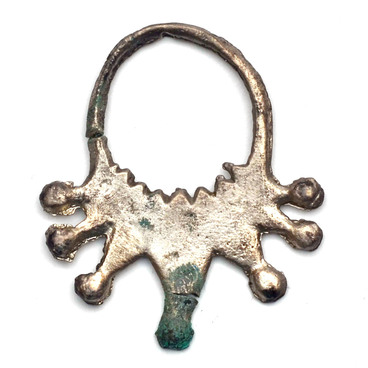This bronze axe with a hanging pole was discovered in 1946 in the town of Beshits, Bryansk region. A spearhead was discovered close by. The scientists made a conclusion that these items were part of a tribal leader burial.
Axe with a hanging pole
Creation period
Third quarter of the II millennium BC
Dimensions
18x3,5 cm
18х3,5 sm
18х3,5 sm
Technique
Bronze, casting
Collection
Exhibition
1
Open in app#1
Axe with a hanging pole
#2
#3
Axes of this sort were made in the end of the II millennium BC. At that time, the middle Dnepr tribes inhabited the modern Bryansk region. They came from the western and south-western lands, partly drove off and partly mixed with the Finno-Ugrian inhabitants. Archeologists found many items from that period in the Bryansk region. Among these were ceramic vessels with curl cord ornaments, bronze daggers, axes and spearheads.
#4
Axes with hanging poles were used as weapons. Their name can be explained by a pole which is situated lower than the blade, as if ‘hanging’ below it. Such items were also called socketed axes: they had internal sockets with a handle fixed inside it. Sometimes the axes were decorated with ornaments but more often they were smooth. There was no need for decorative components on weapons of war.
There were no bronze allows in the Bryansk region. By using chemical examination scientists discovered that at that time this metal was brought here from the North Caucasus and later the Balkans. It was used to make not only weapons but also domestic knifes, sewing awls and different jewelry including necklaces, temple rings and bracelets.
#5
Axe with a hanging pole from the ‘Bryansk antiquities’ collection was casted form bronze as a whole, its handle has not been preserved up to our days. The item has a bent quite long narrow blade. This weapon was suitable for close-in combat: its massive war-head increased momentum after swinging whereas its long handle allowed to keep enough distance between the enemies.
#6
Middle Dnepr tribes considered metallic weaponry to be a symbol of generic authority. Only tribal leaders and high-ranking warriors had access to such weapons – axes were found only in their burial mounds. Burial sites were quite modest and usually contained several types of weapons and ceramic vessels and, less frequently, bronze jewelry. Archeologists never found any luxury articles in the burial mounds.
#7
Bryansk State Regional Ethnography Museum, a State budgetary cultural institution
read morehide
00:00
00:00
1x
Axe with a hanging pole
Creation period
Third quarter of the II millennium BC
Dimensions
18x3,5 cm
18х3,5 sm
18х3,5 sm
Technique
Bronze, casting
Collection
Exhibition
1
Open in app
Share

